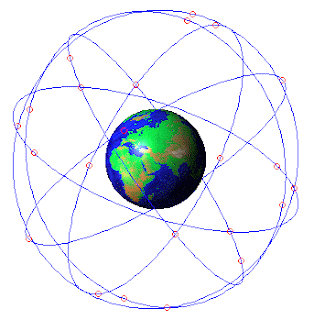
When GPS was first being put into service, the US military was concerned about the possibility of enemy forces using the globally-available GPS signals to guide their own weapon systems. To avoid this, the main "coarse acquisition" signal (C/A) transmitted on the L1 frequency (1575.42MHz) was deliberately degraded by offsetting its clock signal by a random amount, equivalent to about 100 meters of distance. This technique, known as "Selective Availability", or SA for short, seriously degraded the usefulness of the GPS signal for non-military users. More accurate guidance was possible for users of dual frequency GPS receivers that also received the L2 frequency (1227.6MHz), but the L2 transmission, intended for military use, was encrypted and was only available to authorised users with the encryption keys.

This presented a problem for civilian users who relied upon ground-based radio navigation systems such as LORAN, VOR and NDB systems costing millions of dollars each year to maintain. The advent of a global navigation satellite system (GNSS) could provide greatly improved accuracy and performance at a fraction of the cost. The accuracy inherent in the S/A signal was however too poor to make this realistic. The military received multiple requests from the Federal Aviation Administration (FAA), United States Coast Guard (USCG) and United States Department of Transportation (DOT) to set S/A aside to enable civilian use of GNSS, but remained steadfast in its objection on grounds of security.
Through the early to mid 1980s, a number of agencies developed a solution to the SA "problem". Since the SA signal was changed slowly, the effect of its offset on positioning was relatively fixed – that is, if the offset was "100 meters to the east", that offset would be true over a relatively wide area. This suggested that broadcasting this offset to local GPS receivers could eliminate the effects of SA, resulting in measurements closer to GPS's theoretical performance, around 15 meters. Additionally, another major source of errors in a GPS fix is due to transmission delays in the ionosphere, which could also be measured and corrected for in the broadcast. This offered an improvement to about 5 meters accuracy, more than enough for most civilian needs.
The US Coast Guard was one of the more aggressive proponents of the DGPS system, experimenting with the system on an ever-wider basis through the late 1980s and early 1990s. These signals are broadcast on marine longwave frequencies, which could be received on existing radiotelephones and fed into suitably equipped GPS receivers. Almost all major GPS vendors offered units with DGPS inputs, not only for the USCG signals, but also aviation units on either VHF or commercial AM radio bands.
They started sending out "production quality" DGPS signals on a limited basis in 1996, and rapidly expanded the network to cover most US ports of call, as well as the Saint Lawrence Seaway in partnership with the Canadian Coast Guard. Plans were put into place to expand the system across the US, but this would not be easy. The quality of the DGPS corrections generally fell with distance, and most large transmitters capable of covering large areas tend to cluster near cities. This meant that lower-population areas, notably in the midwest and Alaska, would have little coverage by ground-based GPS.
Instead, the FAA (and others) started studies for broadcasting the signals across the entire hemisphere from communications satellites in geostationary orbit. This has led to the Wide Area Augmentation System (WAAS) and similar systems, although these are generally not referred to as DGPS, or alternately, "wide-area DGPS". WAAS offers accuracy similar to the USCG's ground-based DGPS networks, and there has been some argument that the latter will be turned off as WAAS becomes fully operational.

By the mid-1990s it was clear that the SA system was no longer useful in its intended role. DGPS would render it ineffective over the US, precisely where it was considered most needed. Additionally, experience during the Gulf War demonstrated that the widespread use of civilian receivers by U.S. forces meant that SA was thought to harm the U.S. more than if it were turned off.[citation needed] After many years of pressure, it took an executive order by President Bill Clinton to get SA turned off permanently in 2000.
Nevertheless, by this point DGPS had evolved into a system for providing more accuracy than even a non-SA GPS signal could provide on its own. There are several other sources of error that share the same characteristics as SA in that they are the same over large areas and for "reasonable" amounts of time. These include the ionospheric effects mentioned earlier, as well as errors in the satellite position ephemeris data and clock drift on the satellites. Depending on the amount of data being sent in the DGPS correction signal, correcting for these effects can reduce the error significantly, the best implementations offering accuracies of under 10 cm.
In addition to continued deployments of the USCG and FAA sponsored systems, a number of vendors have created commercial DGPS services, selling their signal (or receivers for it) to users who require better accuracy than the nominal 15 meters GPS offers. Almost all commercial GPS units, even hand-held units, now offer DGPS data inputs, and many also support WAAS directly. To some degree, a form of DGPS is now a natural part of most GPS operations.



